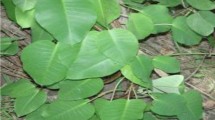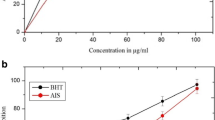Abstract
Since reactive oxygen species (ROS) and hydroxyl radicals (OH) play an important role in the pathogenesis of many human degenerative diseases, much attention has focused on the development of safe and effective antioxidants. Preliminary experiments have revealed that the methanol (MeOH) extract of the stem ofPrunus davidiana exerts inhibitory/scavenging activities on 1,1-diphenyl-2-picrylhydrazyl (DPPH) radicals, total ROS and peroxynitrites (ONOO-). In the present study, the antioxidant activities of this MeOH extract and the organic solvent-soluble fractions, dichloromethane (CH2CI2), ethyl acetate (EtOAc), and n-butanol (n-BuOH), and the water layer ofP. davidiana stem were evaluated for the potential to inhibit OH and total ROS generation in kidney homogenates using 2′,7′-dichlorodihydrofluorescein diacetate (DCHF-DA), and for the potential to scavenge authentic ONOO-. We also evaluated the inhibitory activity of seven flavonoids isolated fromP. davidiana stem, kaempferol, kaempferol 7-O-β-D-glucoside, (+)-catechin, dihydrokaempferol, hesperetin 5-O-β-D-glucoside, naringenin and its 7-O-β-D-glucoside, on the total ROS, OH and ONOO- systems. For the further elucidation of the structure-inhibitory activity relationship of flavonoids on total ROS and OH generation, we measured the antioxidant activity of sixteen flavonoids available, including three active flavonoids isolated fromP. davidiana, on the total ROS and OH systems. We found that the inhibitory activity on total ROS generation increases in strength with more numerous hydroxyl groups on their structures. Also, the presence of anortho-hydroxyl group, whether on the A-ring or B-ring, and a 3-hydroxyl group on the C-ring increased the inhibitory activity on both total ROS and OH generation.
Similar content being viewed by others
References
Ames, B. N., Shigenaga, M. K., and Hage, T. M., Oxidants, antioxidants and the degenerative diseases of aging.Proc. Natl. Acad. Sci. USA, 90, 7915–7922 (1993).
Aruoma, O. I., Assessment of potential prooxidant and antioxidant actions,J. Am. Oil Chem. Soc., 73, 1617–1625 (1996).
Balavoine G. G. and Genleti, Y. V., Peroxynitrite scavenging by different antioxidants, Part I: convenient assay.Nitric Oxide, 3, 40–54 (1999).
Beckman, J. S., Beckman, T. W., Chen, J., Marshell, P. A., and Freeman, B. A., Apparent hydroxyl radical production by peroxynitrite: implications for endothelial injury from nitric oxide and superoxide.Proc. Natl. Acad. Sci., USA, 87, 1620–1624 (1990).
Branen, A. L., Toxicology and biochemistry of butylated hydroxy-anisole and butylated hydroxytoluene.J. Am. Oil Chem.Soc., 52, 59–63 (1975).
Burda, S. and Oleszek, W., Antioxidant and antiradical activities of flavonoids.J. Agric. Food Chem., 49, 2774–2779 (2001).
Choi, J. S., Chung, H. Y, Kang, S. S., Jung, M. J., Kim, J. W., No, J. K. and Jung, H. A., The structure-activity relationship of flavonoids as scavengers of peroxynitrite.Phytochem. Res., 16, 232–235 (2002).
Choi, J. S., Suh, S. S., Young, H. S., and Park, H. J., Hypolipemic and hypoglycemic activities ofPrunus davidiana in high fat-fed rats.Arch. Pharm. Res., 14, 44–47 (1991a).
Choi, J. S., Yokozawa, T., and Oura, H., Improvement of hyperglycemia and hyperlipemia in streptozotocin-diabetic rats by a methanolic extract ofPrunus davidiana stems and its main component, prunin.Plant Med., 57, 208–211 (1991b).
Choi, J. S., Yokozawa, T., and Oura H., Antihyperlipidemic effect of flavonoids fromPrunus davidiana.J. Nat. Prod., 54, 218–224 (1991c).
Choi, J. S., Young, H. S., Lee, T. W., Woo, W. S., and Lee, E. B., Chemistry and anti-inflammatory activity ofPrunus davidiana stems.Yakhak Hoeji, 36, 115–119 (1992).
Choi, J. S., Lee, H. J., Park, H. J., and Kim, H. G., Screening of plants and marine algae and its active principles fromPrunus davidiana.Kor. J. Pharmacogn., 24, 299–303 (1993).
Choi, J. S., Park, K. Y., Moon, S. H., Rhee, S. H., and Young, H. S., Antimutagenic effect of plant of flavonoids in theSalmonella assay system.Arch. Pharm. Res., 17, 71–75 (1994).
Choi, J. S., Park, S. H., and Choi, J. H., Nitrite scavenging effect by flavonoids and its structure-effect relationship.Arch. Pharm. Res., 12, 26–33 (1989).
Choi, J. S., Woo, W. S., Young, H. S., and Park, H. S., Phytochemical study onPrunus davidiana.Arch. Pharm. Res., 13, 374–378 (1990).
Cos, P., Ying, L, Calomme, M., Hu, J. P., Cimanga, K., Poel, B. V., Pieters, L., Vlietinck, A. J., and Berghe, D., Structure-activity relationship and classification of flavonoids as inhibitors of xanthine oxidase and superoxide scavengers.J. Nat. Prod., 61, 71–76 (1998).
Dreher, D. and Junod, F., Role of oxygen free radicals in cancer development.Eur. J. Cancer, 32A(1), 30–38 (1996).
Griffiths, H. R. and Lunec, J., The C1q binding activity of IgG is modifiedin vitro by reactive oxygen species: implications for rheumatoid arthritis.FEBS Lett., 388, 161–164 (1996).
Harbome, F. B. and Williams, C. A., Advances in flavonoid research since 1992.Phytochem., 55, 481–504 (2000).
Jung, H. A., Kim, A. R., Chung, H. Y., and Choi, J. S.,In vitro antioxidant activity of some selectedPrunus species in Korea.Arch. Pharm. Res., 25, 865–872 (2002).
Kooy, N. W., Royall, J. A., Ischiropoulos, H., and Beckman, J. S., Peroxynitrite-mediated oxidation of dihydrorhodamine 123.Free Radic. Biol. Med., 16, 149–156 (1994).
Krishnamachari, V., Levine, L., and Paré, P. W., Flavonoid oxidation by the radical generator AIBN: a unified mechanism for quercetin radical scavenging.J. Agric. Food Chem., 50, 4357–4363 (2002).
Label, C. P. and Bondy, S. C, Sensitive and rapid quantitation of oxygen reactive species formation in rat synaptosomes.Neurochem. Int., 17, 435–441 (1990).
Lee, W. R., Shen, S. C., Lin, H. Y., Hou, W. C., Yang, L. L., and Chen, Y C., Wogonin and fisetin induce apoptosis in human promyeloleukemic cells, accompanied by a decrease of reactive oxygen species, and activation of caspase 3 and Ca2+-dependent endonuclease.Biochem. Pharmacol., 63, 225–236 (2002).
Morel, I., Lescoat, G., Cognel, P., Sergent, O., Pasdelop, N., Brissot, P., Cillard, P., and Cillard, J., Antioxidant and iron-chelating activities of the flavonoids, catechin, quercetin and diosmetin, on iron-loaded rat hepatocyte cultures.Biochem. Pharmacol., 45, 13–19 (1993).
Nagao, A., Seki, M., and Kobayashi, H., Inhibition of xanthine oxidase by flavonoids.Biosci. Biotechnol. Biochem., 63, 1787–1790 (1999).
Park, H. S., Young, H. S., Park, K. Y., Rhee, S. H., Chung, H. Y., and Choi, J. S., Flavonoids from the whole plants ofOrostachysjaponicus.Arch. Pharm. Res., 14, 167–171 (1991).
Pincemail, J. J., Free radicals and antioxidants in human diseases. In Favier, A. E., Cadet, J., Kalyanaraman, B., Fontecave, M., and Pierre, J.-L.,Analysis of Free radicals in Biological Systems. Birkhauser Verlag, Berlin, pp. 83–98, (1995).
Rice-Evans, C. A., Miller, N., and Paganga, G., Antioxidant properties of phenolic compounds.Trends in Plant Science, 2, 152–159 (1997).
Rice-Evans, C. A., Miller, N., and Paganga, G., Structure-antioxidant activity relationships of flavonoids and phenolic acids.Free Radic. Biol. Med., 20, 933–956 (1996).
Sagar, S., Kallo, I. J., Kaul, N., Ganguly, N. K., and Sharma, B. K., Oxygen free radicals in essential hypertension.Mol. Cell Biochem., 111, 103–108 (1992).
Salah, N., Miller, N. J., Paganga, G., Tijburg, L, Bolwell, G. P., and Rice-Evans, C. A., Polyphenolic flavonols as scavengers of aqueous phase radicals and as chain-breaking antioxidants.Arch. Biochem. Biophys., 322, 339–346 (1995).
Sawa, T., Akaike, T., and Maeda, H., Tyrosine nitration by per-oxynitrite formed nitric oxide and superoxide generated by xanthine oxidase.J. Biol. Chem., 275(42), 32467–32474 (2000).
Singh, A., Chemical and biochemical aspects of activated oxygen: singlet oxygen, superoxide anion, and related species, In Miquel, J., Quintanilha, A. T, and Weber, H. (Eds).CRC Handbook of free radicals and antioxidants in Biomedicine. CRC Press, Inc., Boca Raton, Florida, Vol. 1, pp. 17–28, (1989).
Sohal, R. S., Role of oxidative stress and protein oxidation in the aging process.Free Radic. Biol. Med., 33(1), 37–44 (2002).
Squadrito, G. L. and Pryor, W. A., Oxidative chemistry of nitric oxide: the role of superoxide, peroxynitrite, and carbon dioxide.Free Radic. Biol. Med., 25, 392–403 (1998).
Ueda, J., Saito, N., Shimazu, Y., and Ozawa, T., A comparison of scavenging abilities of antioxidants against hydroxyl radicals.Arch. Biochem. Biophys., 333, 377–384 (1996).
Van Acker, S. A. B. E., Van Balen, G. P., Van den Berg, D. J., Bast, A., and Van der Vijgh, W. J. F., Influence of iron chelation on the antioxidant activity of flavonoids.Biochem. Pharmacol., 56, 935–943 (1998).
Author information
Authors and Affiliations
Corresponding author
Rights and permissions
About this article
Cite this article
Jung, H.A., Jung, M.J., Kim, J.Y. et al. Inhibitory activity of flavonoids fromPrunus davidiana and other flavonoids on total ROS and hydroxyl radical generation. Arch Pharm Res 26, 809–815 (2003). https://doi.org/10.1007/BF02980025
Received:
Issue Date:
DOI: https://doi.org/10.1007/BF02980025




